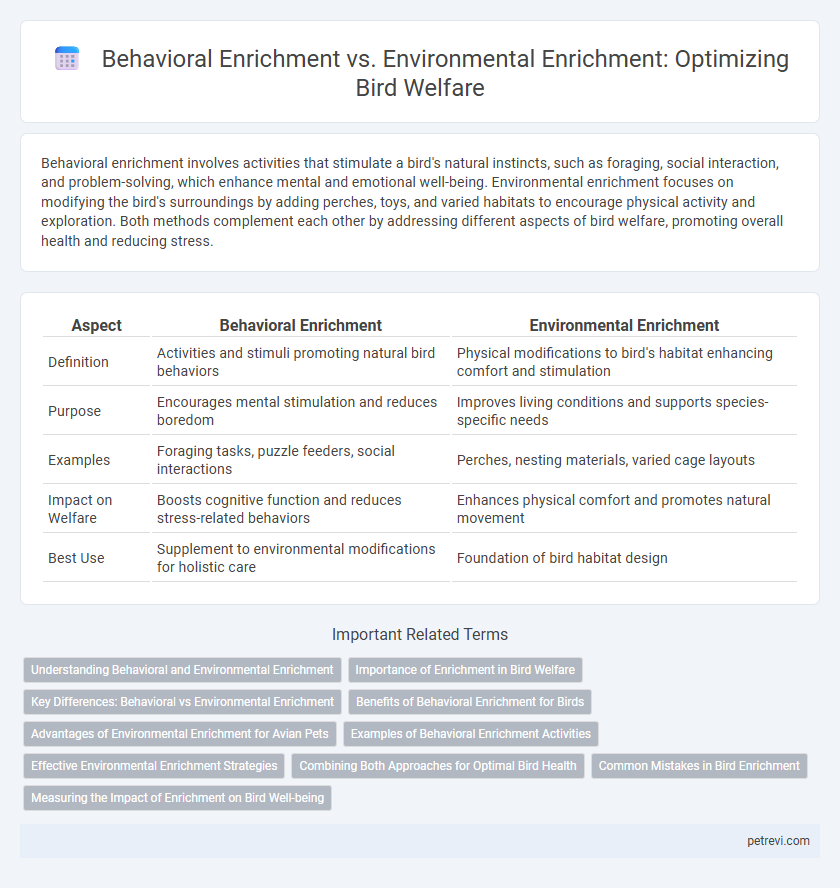Behavioral enrichment involves activities that stimulate a bird's natural instincts, such as foraging, social interaction, and problem-solving, which enhance mental and emotional well-being. Environmental enrichment focuses on modifying the bird's surroundings by adding perches, toys, and varied habitats to encourage physical activity and exploration. Both methods complement each other by addressing different aspects of bird welfare, promoting overall health and reducing stress.
Table of Comparison
| Aspect | Behavioral Enrichment | Environmental Enrichment |
|---|---|---|
| Definition | Activities and stimuli promoting natural bird behaviors | Physical modifications to bird's habitat enhancing comfort and stimulation |
| Purpose | Encourages mental stimulation and reduces boredom | Improves living conditions and supports species-specific needs |
| Examples | Foraging tasks, puzzle feeders, social interactions | Perches, nesting materials, varied cage layouts |
| Impact on Welfare | Boosts cognitive function and reduces stress-related behaviors | Enhances physical comfort and promotes natural movement |
| Best Use | Supplement to environmental modifications for holistic care | Foundation of bird habitat design |
Understanding Behavioral and Environmental Enrichment
Behavioral enrichment for birds involves stimulating natural behaviors through activities like foraging, social interaction, and problem-solving, which enhances cognitive function and reduces stress. Environmental enrichment focuses on modifying the physical surroundings, such as providing perches, varied substrates, and nesting materials that mimic natural habitats to promote physical health and comfort. Integrating both strategies supports comprehensive welfare by addressing psychological and physical needs essential for birds' overall well-being.
Importance of Enrichment in Bird Welfare
Behavioral enrichment enhances bird welfare by encouraging natural behaviors such as foraging, singing, and social interactions that reduce stress and prevent boredom. Environmental enrichment improves habitat complexity through varied perches, nesting sites, and sensory stimuli, creating a stimulating and comfortable space that promotes physical and mental health. Combining both enrichment types is crucial for optimizing cognitive function, emotional well-being, and overall quality of life in captive and domestic birds.
Key Differences: Behavioral vs Environmental Enrichment
Behavioral enrichment for birds involves activities and stimuli that encourage natural behaviors such as foraging, singing, and social interaction, promoting mental and physical well-being. Environmental enrichment pertains to modifications in the habitat, including perches, nest boxes, and vegetation, designed to create a stimulating and safe living space. The key difference lies in behavioral enrichment targeting the bird's actions directly, while environmental enrichment focuses on enhancing the surrounding physical environment.
Benefits of Behavioral Enrichment for Birds
Behavioral enrichment for birds enhances mental stimulation and encourages natural activities such as foraging, problem-solving, and social interactions, which are essential for preventing boredom and stress. This form of enrichment promotes cognitive development and improves overall welfare by fostering behaviors that replicate those found in wild habitats. Birds exposed to behavioral enrichment exhibit increased activity levels, reduced signs of anxiety, and stronger immune responses, contributing to a healthier and more balanced life.
Advantages of Environmental Enrichment for Avian Pets
Environmental enrichment for avian pets enhances natural behaviors by providing stimuli such as perches, foraging opportunities, and varied textures, promoting mental and physical health. It reduces stress and aggression by simulating natural habitats, leading to improved overall welfare and longevity. Unlike behavioral enrichment, environmental enrichment requires less direct human interaction, making it sustainable and effective for long-term bird care.
Examples of Behavioral Enrichment Activities
Behavioral enrichment for birds involves activities that stimulate natural behaviors such as foraging, problem-solving, and social interaction, including puzzle feeders, foraging mats, and interactive toys. These activities promote mental engagement and reduce stress by mimicking challenges encountered in the wild, enhancing overall bird welfare. In contrast, environmental enrichment focuses on modifying the physical habitat with elements like perches, plants, and varied cage layouts to create a more dynamic living space.
Effective Environmental Enrichment Strategies
Effective environmental enrichment strategies for birds include providing naturalistic habitats that encourage flight, foraging, and social interaction, which enhance mental stimulation and reduce stress-related behaviors. Incorporating varied perches, live plants, and interactive feeding devices promotes physical activity and natural behaviors critical for bird welfare. Behavioral enrichment often complements these strategies by teaching birds new skills and encouraging problem-solving, but optimizing the physical environment remains foundational for sustaining long-term health and well-being.
Combining Both Approaches for Optimal Bird Health
Combining behavioral enrichment and environmental enrichment significantly enhances bird welfare by addressing both the mental stimulation and physical needs essential for optimal health. Behavioral enrichment, such as training, problem-solving tasks, and social interaction, complements environmental enrichment like varied perches, natural vegetation, and aviary complexity, creating a holistic habitat. This integrated approach reduces stress, encourages natural behaviors, and promotes physical fitness, ultimately leading to improved longevity and quality of life for captive or domestic birds.
Common Mistakes in Bird Enrichment
Common mistakes in bird enrichment often include conflating behavioral enrichment with environmental enrichment, leading to inadequate stimulation of natural behaviors. Behavioral enrichment targets specific actions like foraging or vocalization, while environmental enrichment modifies the habitat to promote exploration and comfort. Neglecting either aspect can result in stress, boredom, and repetitive behaviors in captive birds, ultimately undermining their welfare.
Measuring the Impact of Enrichment on Bird Well-being
Behavioral enrichment enhances bird welfare by stimulating natural behaviors such as foraging, social interaction, and vocalization, leading to reduced stress and improved mental health. Environmental enrichment improves habitat complexity through elements like perches, nesting materials, and varied substrates, promoting physical activity and cognitive engagement. Measuring the impact on bird well-being involves assessing changes in behavioral diversity, stress hormone levels, and overall health indicators using systematic observation and physiological monitoring.
Behavioral enrichment vs Environmental enrichment for Bird welfare Infographic

 petrevi.com
petrevi.com